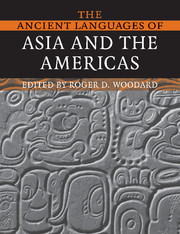Book contents
- Frontmatter
- Contents
- List of figures
- List of tables
- List of maps
- List of contributors
- Notes on numbering and cross-referencing
- List of abbreviations
- Preface
- Preface to the first edition
- 1 Language in ancient Asia and the Americas: an introduction
- 2 Sanskrit
- 3 Middle Indic
- 4 Old Tamil
- 5 Old Persian
- 6 Avestan
- 7 Pahlavi
- 8 Ancient Chinese
- 9 Mayan
- 10 Epi-Olmec
- Appendix 1 Reconstructed ancient languages
- Appendix 2 Full tables of contents from The Cambridge Encyclopedia of the World's Ancient Languages, and from the other volumes in the paperback series
- Index of general subjects
- Index of grammar and linguistics
- Index of languages
- Index of named linguistic laws and principles
Appendix 1 - Reconstructed ancient languages
Published online by Cambridge University Press: 01 September 2010
- Frontmatter
- Contents
- List of figures
- List of tables
- List of maps
- List of contributors
- Notes on numbering and cross-referencing
- List of abbreviations
- Preface
- Preface to the first edition
- 1 Language in ancient Asia and the Americas: an introduction
- 2 Sanskrit
- 3 Middle Indic
- 4 Old Tamil
- 5 Old Persian
- 6 Avestan
- 7 Pahlavi
- 8 Ancient Chinese
- 9 Mayan
- 10 Epi-Olmec
- Appendix 1 Reconstructed ancient languages
- Appendix 2 Full tables of contents from The Cambridge Encyclopedia of the World's Ancient Languages, and from the other volumes in the paperback series
- Index of general subjects
- Index of grammar and linguistics
- Index of languages
- Index of named linguistic laws and principles
Summary
Introduction
This chapter will necessarily be rather different from most of those that precede, since it deals with languages of which no direct record survives – languages which are, by definition, prehistoric. Prehistoric languages can only be studied inferentially, and the only sound basis for our inferences is the well-known uniformitarian principle (UP). As applied in historical linguistics, the UP states the following:
(1) If the conditions of language use and acquisition cannot be demonstrated to have undergone any relevant alteration between the prehistoric and historical periods, nor between recorded history and the present, we must assume that the same types of language structures and language changes that we can observe today also underlie our historical records and were present in prehistory as well.
Since the only alternative is unconstrained guesswork, all scientific historical linguists must take the UP seriously. It follows that we must not interpret what we find in the written historical record in any way that is inconsistent with the range of structures and changesin-progress that we can observe in languages currently spoken, nor must we posit for a prehistoric language any type of structure or change that is not actually attested somewhere among the known languages of theworld. This very general principle has remarkably specific consequences, especiallywith regard to phonological change (see §3 below), which constrain and guide our hypotheses with a precision often surprising to interested observers outside the field.
- Type
- Chapter
- Information
- The Ancient Languages of Asia and the Americas , pp. 234 - 250Publisher: Cambridge University PressPrint publication year: 2008



